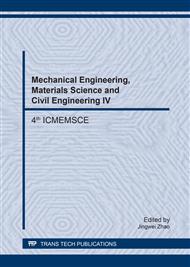p.174
p.181
p.186
p.190
p.195
p.202
p.207
p.212
p.218
The Effect of Reduction Parameter in Processing Lump Ore with Green Sugarcane Bagasse Reductor in Muffle Furnace
Abstract:
Sugarcane bagasse has demonstrated its ability to act as a reductor in iron-reduction process. As a reductor, bagasse has specialties as double-acting reductor equiped with volatile matter. This is the first study of the use of bagasse as reductor in iron-reduction process. The parameter concluded from this study was used for the second study which report has been submitted for publication. The aim of this study is to discuss the effect of reduction process parameter to the use of bagasse as reductor. This study was divided into 2 step. The first step is determining the optimum reduction process temperature and weight ratio. The reduction temperature varied as 700, 800, 900 and 1000 °C and the weight ratio are 1:2 and 1:4. The process duration is 30 minutes. The second stape is determining the process duration. The process duration will be varied as 30, 45 and 60 minutes. The condition of bagasse is air dried basis. The result shows that the reduction process produced wustite (FeO).
Info:
Periodical:
Pages:
195-201
Citation:
Online since:
March 2017
Keywords:
Price:
Сopyright:
© 2017 Trans Tech Publications Ltd. All Rights Reserved
Share:
Citation:


